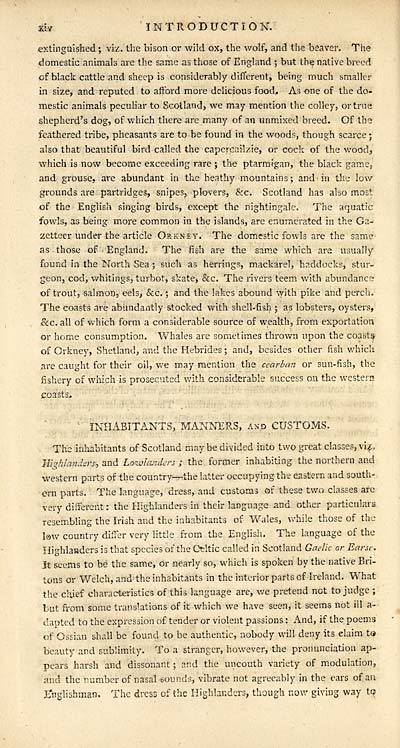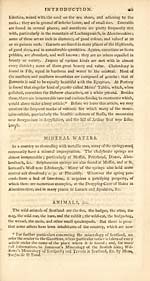Gazetteer of Scotland
(26) Page xiv
Download files
Complete book:
Individual page:
Thumbnail gallery: Grid view | List view

mi 'INTRODUCTION.
extinguished ; viz. the bison or wild ox, the wolf, and the beaver. The
domestic animals are the same as those of England ; but the native breed
of black cattle and sheep is considerably different, being much smaller
in size, and reputed to afford more delicious food. As one of the do-
mestic animals peculiar to Scotland, we may mention the colley, or true
shepherd's dog, of which there are many of an unmixed breed. Of the
feathered tribe, pheasants are to be found in the woods, though scarce •
also that beautiful bird called the capercailzie, or cock of the wood,
which is now become exceeding rare ; the ptarmigan, the black game s
and grouse, are abundant in the heathy mountains; and' in the low
grounds are partridges, snipes, plovers, &c. Scotland has also most
of the English singing birds, except the nightingale. The aquatic
fowls, as being more common in the islands, are enumerated in the Ga-
zetteer under the article Orkney. The domestic fowls are the same
as those of i England. The fish are the same which are usually
found in the North Sea ; such as herrings, mackarel, haddocks, stur-
geon, cod, whitings, turbot, skate, &c. The rivers teem with abundance
of trout, salmon, eels, &c. ; and the lakes abound with pike and perch.
The coasts are abundantly stocked with shell-fish ; as lobsters, oysters,
&c. all of which form a considerable source of wealth, from exportation
or home consumption. Whales are sometimes thrown upon the coasts;
of Orkney, Shetland, and the Hebrides ; and, besides other fish which
are caught for their oil, we may mention the cearban or sun-fish, the
fishery of which is prosecuted with considerable success on the western
coasts,
' INHABITANTS, MANNERS, and CUSTOMS.
The inhabitants of Scotland may be divided into two great classes, ?%
Highlanders, and Lowlandcrs ; the former inhabiting the northern and
western parts of the country— the latter occupying the eastern and south-
ern parts. The language, dress, and customs of these two classes are
very different : the Highlanders in their language and other particulars
resembling the Irish and the inhabitants of Wales, while those of the
law country differ very little from the English. The language of the
Highlanders is that species of the Celtic called in Scotland Gaelic or Earse.
It seems to be the same, or nearly so, which is spoken by the native Bri-
tons or Welch, and the inhabitants in the interior parts of Ireland. What
the chief characteristics of this language are, we pretend not to judge ;
but from some translations of it which we have seen, it seems not ill a-
dapted to the expression of tender or violent passions : And, if the poems
of Ossian shall be found to be authentic, nobody will deny its claim to
beauty and sublimity. To a stranger, however, the pronunciation ap-
pears harsh and dissonant ; and the uncouth variety of modulation,
and the number of nasal -sounds, vibrate not agreeably in the ears of an
Englishman. The dress of the Highlanders, though now giving way to
extinguished ; viz. the bison or wild ox, the wolf, and the beaver. The
domestic animals are the same as those of England ; but the native breed
of black cattle and sheep is considerably different, being much smaller
in size, and reputed to afford more delicious food. As one of the do-
mestic animals peculiar to Scotland, we may mention the colley, or true
shepherd's dog, of which there are many of an unmixed breed. Of the
feathered tribe, pheasants are to be found in the woods, though scarce •
also that beautiful bird called the capercailzie, or cock of the wood,
which is now become exceeding rare ; the ptarmigan, the black game s
and grouse, are abundant in the heathy mountains; and' in the low
grounds are partridges, snipes, plovers, &c. Scotland has also most
of the English singing birds, except the nightingale. The aquatic
fowls, as being more common in the islands, are enumerated in the Ga-
zetteer under the article Orkney. The domestic fowls are the same
as those of i England. The fish are the same which are usually
found in the North Sea ; such as herrings, mackarel, haddocks, stur-
geon, cod, whitings, turbot, skate, &c. The rivers teem with abundance
of trout, salmon, eels, &c. ; and the lakes abound with pike and perch.
The coasts are abundantly stocked with shell-fish ; as lobsters, oysters,
&c. all of which form a considerable source of wealth, from exportation
or home consumption. Whales are sometimes thrown upon the coasts;
of Orkney, Shetland, and the Hebrides ; and, besides other fish which
are caught for their oil, we may mention the cearban or sun-fish, the
fishery of which is prosecuted with considerable success on the western
coasts,
' INHABITANTS, MANNERS, and CUSTOMS.
The inhabitants of Scotland may be divided into two great classes, ?%
Highlanders, and Lowlandcrs ; the former inhabiting the northern and
western parts of the country— the latter occupying the eastern and south-
ern parts. The language, dress, and customs of these two classes are
very different : the Highlanders in their language and other particulars
resembling the Irish and the inhabitants of Wales, while those of the
law country differ very little from the English. The language of the
Highlanders is that species of the Celtic called in Scotland Gaelic or Earse.
It seems to be the same, or nearly so, which is spoken by the native Bri-
tons or Welch, and the inhabitants in the interior parts of Ireland. What
the chief characteristics of this language are, we pretend not to judge ;
but from some translations of it which we have seen, it seems not ill a-
dapted to the expression of tender or violent passions : And, if the poems
of Ossian shall be found to be authentic, nobody will deny its claim to
beauty and sublimity. To a stranger, however, the pronunciation ap-
pears harsh and dissonant ; and the uncouth variety of modulation,
and the number of nasal -sounds, vibrate not agreeably in the ears of an
Englishman. The dress of the Highlanders, though now giving way to
Set display mode to: Large image | Transcription
Images and transcriptions on this page, including medium image downloads, may be used under the Creative Commons Attribution 4.0 International Licence unless otherwise stated. ![]()
| Gazetteers of Scotland, 1803-1901 > Gazetteer of Scotland > (26) Page xiv |
|---|
| Permanent URL | https://digital.nls.uk/97414874 |
|---|

